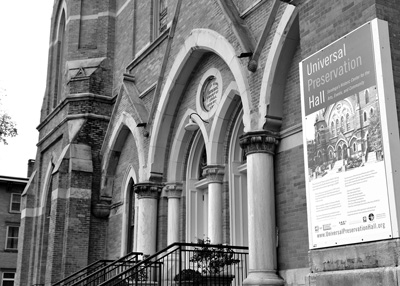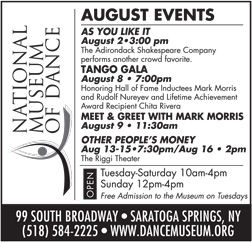News & Issues August 2015
Alliance boosts a fledgling arts temple
Performing arts venue in former church joins forces with Proctors
 By THOMAS DIMOPOULOS
By THOMAS DIMOPOULOS
Contributing writer
SARATOGA SPRINGS, N.Y.
Universal Preservation Hall, a performing arts center in a former church in downtown Saratoga Springs, has formed a new operating alliance with Proctors, the historic theater in Schenectady.
Joan K. Lentini photo
A long-running effort to transform a grand old church building in downtown Saratoga Springs into a thriving performance and community center appears set to take a big step forward.
Last month, leaders of the Universal Preservation Hall, the towering former Methodist church that the community rallied to save from demolition more than a decade ago, announced a new operating alliance with Proctors, the historic theater in downtown Schenectady that has served as a performing arts destination in that city since the 1970s.
Local officials hope the new partnership will allow Universal Preservation Hall, a 144-year-old Victorian Gothic structure on Washington Street a block west of Broadway, to fill a void in a city where the current performing arts spaces are either small and intimate or very large.
Saratoga Springs has lacked a year-round, mid-sized performing-arts venue since fire destroyed the 5,000-seat Convention Hall in 1965. In recent decades, city leaders developed the Saratoga Springs City Center, which is more suitable for business conferences and trade shows than the performing arts. The Saratoga Performing Arts Center, built in the late 1960s, can accommodate a crowd of 25,000 for a rock concert, but it’s only open in the summer and isn’t suited to many smaller-scale events.
Downtown, Caffè Lena is a legendary performance space but can hold a maximum of about 80 people. And while the recently constructed Zankel music building at Skidmore College includes a 600-seat concert hall, it’s largely reserved for college-related activities.
Officials say Universal Preservation Hall, working with Proctors, could soon host a range of musical and theatrical performances that require a venue smaller than SPAC but bigger than Caffe Lena.
“I envision we will have concerts and a number of theatrical events,” said Philip Morris, the chief executive of Proctors. “We’ll probably do a cabaret series of Broadway stars and all kinds of stuff.”
Proctors was built in the early 20th century as a vaudeville theater on State Street in downtown Schenectady. Like Universal Preservation Hall, it also was saved from the wrecking ball, although much earlier, in the 1970s. Today, its main hall can accommodate nearly 2,700 people, and its GE Theatre can seat 400; a third performance space in an adjacent building can accommodate 100.
Having established itself as a major performing arts venue for New York’s Capital Region, Proctors has lent its expertise to other area arts organizations; it shares a management agreement, for example, with Albany’s Capital Repertory Theatre.
Saving a landmark
Universal Preservation Hall, built in 1871, was a Methodist church for its first 100 years and also played a role in the city’s civic life, providing a venue for visiting statesmen including Teddy Roosevelt, William Howard Taft, William Jennings Bryan and Frederick Douglass. But by the 1960s, if had fallen on hard times: Downtown Saratoga was in decline, and the Methodist congregation moved to new building outside of town.
The church sat empty for several years until a local Baptist congregation bought it for $18,000 in 1976. But the Universal Baptist Church, a historically African-American congregation, never had the wherewithal to preserve and restore the aging structure.
In 2000, the city condemned the building. Local preservationists, fearing it would be demolished, organized a nonprofit group and reached out to the Baptist congregation to help save it. The result is a unique arrangement in which the nonprofit group now owns the building and has been slowly working to restore it as a performance venue, while the Baptist congregation still uses a chapel on the lower level for Sunday services and owns the land on which the church sits.
The building features pointed Gothic arches that frame its doors and windows. A pair of walnut and ash staircases feed into the main hall, whose ceiling is 45 feet high. After structural repairs in recent years, the bell tower no longer sags toward the east, and it still houses a 3,000-pound Meneely bell.
Donations raised by the board of the then-new Universal Preservation Hall nonprofit paid for an initial wave of renovation work beginning in 2003.
“It was in pretty rough shape,” recalled Teddy Foster, who joined the board in 2006 and became its president three years later. “The front looked like a bombed-out shelter. They had raised about $3 million at that point and stabilized the building.”
But the restoration effort ground to a halt with the economic collapse of 2008-09.
“In 2009, all the pledges dried up, and everything went to hell in a hand-basket,” Foster said. “That’s when it got really ugly. We had no money. Board members began to jump ship like it was the Titanic, so I got stuck being president.
“I was smart enough to realize I needed either a plan to move forward or an exit plan,” she continued. “You’re remembered not for how you start something but how you leave it. I didn’t want to be remembered as the woman who let down Universal Preservation Hall. So we got busy.”
In short order, the venue was able to book Colin Hay, John Sebastian and Bruce Springsteen and the E Street Band drummer Max Weinberg for performances. But because the renovations were – and still are -- only partly completed, the maximum occupancy of the hall was severely restricted.
“We lost our shirts, but if we hadn’t had that music series, we wouldn’t be where we are today,” Foster said.
Attracting some big-name performers, she explained, raised the hall’s visibility and showcased its potential. The shows also resulted in return visits by a variety of patrons who either became members or offered their help in other ways.
Joining forces
The new alliance with Proctors has been under discussion for several years. The talks began in early 2012, when leaders of the Schenectady organization spent four hours touring the Saratoga hall.
“They fell in love with the place,” Foster recalled.
The two organizations undertook a feasibility study to examine Universal Preservation Hall’s potential role in the competitive regional market of performance venues. The study also analyzed the hall’s staffing requirements and budgets, the best uses for its space and fund-raising options.
Last month, the two groups launched a $4.3 million capital campaign to raise funds to complete the renovation of the building. When the work is complete, the hall will offer 12,000 square feet of performance and public space.
Morris said about $1.3 million has already been identified to support the capital campaign. The goal is to raise the balance of the funds by next spring, close down for a reconstruction project lasting up to a year, and host a grand re-opening in the spring or summer of 2017.
Designs call for a community room and small hall on the ground floor, a hydraulic platform and a fixed stage in the main hall, and a renovated upper balcony. An elevator will be installed to serve all three levels. Other planned upgrades include the installation of new air conditioning and heating units, sprinkler systems, and “audio-enhancing” alterations. Fire-safety upgrades will greatly increase the building’s maximum occupancy.
The changes will allow for up to 800 people to attend events in the flexible-seating main hall, with another 200 or so in the rooms on the ground level. The two organizations aim to schedule stage events year-round, with the hall booked for at least 200 performances or other events annually. Proctors will manage the booking and ticketing, while the preservation hall will continue to function as an independent organization with its own board of directors.
Given its size, the hall also offers an opportunity for collaborative events. Caffè Lena and Universal Preservation Hall are currently partnering in a live music series that in July featured the composer David Amram at the hall and in October will feature a pair of performances by The Howard Fishman Quintet at Caffe Lena. The collaboration is an effort to raise funds and awareness for both organizations, which each are currently in the midst of capital campaigns to support needed renovations.
“UPH has a bigger room, and Caffè Lena has a longer history,” said Sarah Craig, Caffe Lena’s executive director, as she explained how the two organizations partnered on the concert series. “We took our belief that collaboration is good and sat down together and started brainstorming. The biggest beneficiaries are the audience and the artists, but it’s also just a huge shot of positive energy for the presenting organizations.”
In a city where the availability of parking has become a hot issue in recent years, Universal Preservation Hall is located within a few hundred feet of a four-level parking garage on Woodlawn Avenue. The structure, built in 2012, holds about 450 vehicles. The garage will provide easy access to a planned glassed-in entryway to the east of the hall’s current entrance.
“My sense is parking will be sort of like it is at Proctors,” Morris said. “Park at the garage, walk a few hundred feet, and you’re in.”
If all goes well with the fund-raising campaign, Universal Preservation Hall will continue to stage events periodically until it closes for renovation next spring. When it reopens in 2017, it will be able to host much larger audiences and a full, year-round slate of events.


